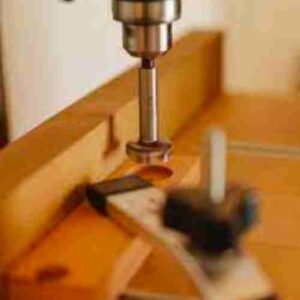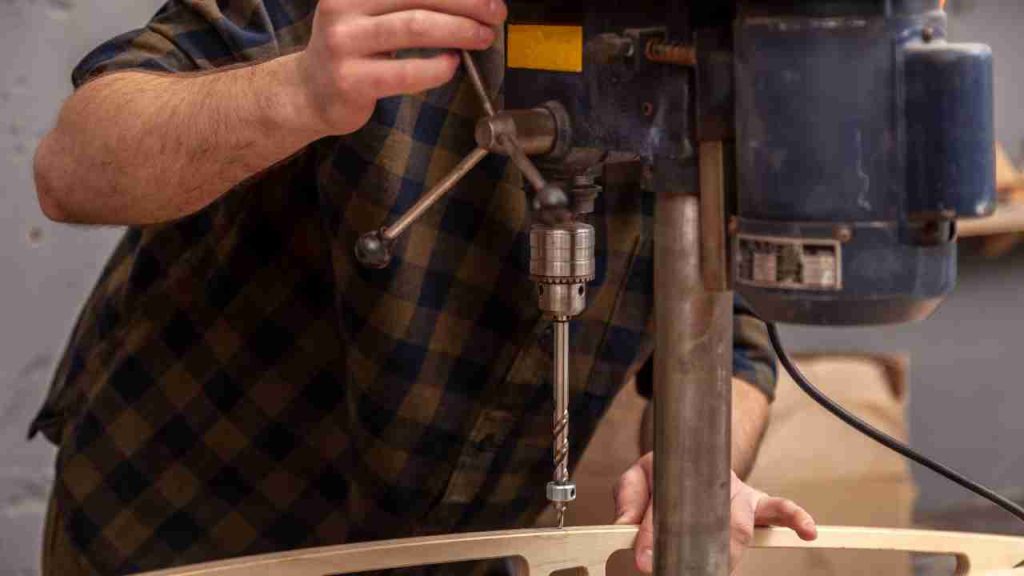Are you a woodworker or metalworker who wants to learn how to use a drill press? If that’s the case, you’ve come to the correct spot! A drill press is an essential equipment in every workshop, providing the power and adaptability needed to make accurate holes in various materials.
But, knowing its numerous components and functions, like with any sophisticated instrument, is critical for safe and successful utilization. The spindle lock is one such component that is sometimes ignored yet plays an important part in your drilling performance.
In this blog article, we’ll delve into the world of drill presses, especially the spindle lock, and learn why this handy little function is necessary for rookie and professional users. Now, let’s start and discover the mystery of drill press spindle locks!
 What is a drill press spindle lock?
What is a drill press spindle lock?
The spindle of a drill press is the portion that holds the chuck, which in turn grips the drill bit. A drill press spindle lock is a safety and convenience device that momentarily immobilizes the spindle and prevents it from turning. The spindle lock facilitates changing drill bits, performing maintenance, or making changes to the tool simpler and safer without the chance of unintentional spinning.
Different Types of Spindle Locks:
There are two types of spindle locks in drill presses: manual and automated. Each kind has benefits and downsides that we shall cover more below.
1. Manual
Manual spindle locks generally employ a button, lever, or knob that must be pressed, flipped, or turned to engage or disengage the lock. This operation positions a locking pin or wedge to prevent the spindle from turning.
- Pros: Manual spindle locks are often straightforward, dependable, and simple. They are also more popular on drill presses and less costly in general when compared to their automated equivalents.
- Cons: The user must remember to manually activate and release the spindle lock, which may be cumbersome or even dangerous if neglected.
2. Automated
When the drill press is switched off or the spindle stops revolving, automatic spindle locks engage automatically. They often utilize an electromechanical system or a spring-loaded device that interacts with the spindle or motor to lock the spindle or motor in place.
- Pros: Automatic spindle locks offer enhanced convenience and safety since they do not need physical activity to engage or disengage. They are particularly useful in avoiding mishaps caused by failing to lock the spindle before changing drill bits or making adjustments.
- Cons: Since automatic spindle locks are more sophisticated, they may be more costly and prone to failure. They are also less prevalent, often appearing on higher-end or newer drill press types.
Purpose of the spindle lock:
The spindle lock on a drill press serves three functions:
- The spindle lock prevents unintentional spinning when changing drill bits, making adjustments, or conducting maintenance by immobilizing the spindle. This reduces the possibility of harm and creates a safer working environment.
- Precision: The spindle lock improves control for procedures that demand constant pressure and depth, such as drilling precise holes or dealing with varied materials. It helps maintain the appropriate position and delivers accurate drilling results by keeping the spindle fixed.
- Convenience: Using the spindle lock allows you to replace drill bits or change the tool without dealing with a spinning spindle. This streamlines the procedure and minimizes the time and effort necessary for these activities, improving the overall user experience.
 How does the spindle lock work?
How does the spindle lock work?
- Identify the spindle lock mechanism: The spindle lock is commonly a button, lever, or knob near the spindle or chuck on the drill press head.
- Engage the spindle lock: When you need to immobilize the spindle, push the button, flip the lever, or turn the knob, depending on the kind of spindle lock on your drill press. This action engages a locking pin or wedge with the spindle and prevents it from turning.
- Execute the required task: With the spindle locked in place, you may securely replace drill bits, make adjustments, or perform drill press maintenance without fear of the spindle unintentionally spinning.
- Disengage the spindle lock: After you’ve finished the needed work, release the button, return the lever to its normal position, or turn the knob back, depending on your drill press model. This movement releases the locking pin or wedge, enabling the spindle to revolve once again freely.
When to Use the Spindle Lock?
- Bit replacements and maintenance: When replacing drill bits, activate the spindle lock to avoid accidental rotation and harm. The same applies to maintenance operations, including cleaning and lubricating the spindle and chuck.
- Repeated drilling tasks: The spindle lock may assist in maintaining consistency and accuracy while drilling many holes at the same depth or working on a succession of comparable workpieces. You may get consistent results across all workpieces by locking the spindle at the specified depth.
- Obtaining accurate hole depths: In projects where precise hole depths are critical, the spindle lock may assist in maintaining measurement accuracy. Locking the spindle at the desired depth guarantees that the drill bit does not travel any deeper than necessary.
- When drilling through materials of varied hardness or thickness, the spindle lock helps maintain constant pressure and depth, resulting in clean and precise holes. This is especially important when switching materials in the same project since it reduces the danger of harming the workpiece or drill bit due to uneven drilling.
Common Spindle Lock Troubleshooting:
Spindle lock stuck:
Cause: Dirt, debris, or a lack of lubrication may cause the spindle lock to get jammed, making it difficult to engage or disengage.
Cleaning the spindle lock mechanism of any dirt or debris causing it to stick is the solution. To guarantee smooth functioning, apply a tiny quantity of lubrication to the moving components.
Spindle lock is ineffective:
The spindle lock may not immobilize the spindle properly owing to wear, breakage, or misalignment of the locking pin or wedge.
Solution:
- Examine the spindle lock mechanism for wear or damage.
- Replace or repair any damaged components.
- Adjust the locking pin or wedge if misplaced to ensure adequate contact with the spindle.
Difficulty in engaging or disengaging:
Cause: Due to wear, misalignment, or inadequate lubrication, the spindle lock may become difficult to operate.
Solution: Examine the spindle lock for indications of wear and replace or repair any damaged components. Make that the locking pin or wedge is correctly aligned with the spindle. To guarantee smooth functioning, apply a tiny quantity of lubrication to the moving components.
Disengagement by accident:
Cause: During operation, the spindle lock may unexpectedly disengage, possibly resulting in an accident or damage to the workpiece.
Examine the spindle lock mechanism for evidence of wear, breakage, or faulty alignment, which might be causing it to disengage accidentally. Repair or replace damaged components as required, and ensure the spindle lock is properly engaged during operation.
Frequently Asked Questions (FAQs)
1. Why is the spindle lock important on a drill press?
The spindle lock is important because it provides safety, precision, and convenience when using a drill press. It prevents unintentional spinning, helps maintain consistent drilling depth and pressure, and simplifies bit changes and adjustments.
2. Can I use a drill press without a spindle lock?
Yes, you can use a drill press without a spindle lock, but it might be less safe and less accurate. The spindle lock adds an extra layer of safety and precision to your drilling tasks, making it a valuable feature to have.
3. Are spindle locks available on all drill presses?
No, not all drill presses come with spindle locks. They are more common on higher-end models and newer drill presses. However, many manual spindle locks can be added to existing drill presses as an aftermarket accessory.
4. How do I know if my drill press has a spindle lock?
To determine if your drill press has a spindle lock, look for a button, lever, or knob near the spindle or chuck on the drill press head. If you’re unsure, consult your drill press user manual or contact the manufacturer for more information.
5. How often should I use the spindle lock?
You should use the spindle lock whenever you need to change drill bits, make adjustments, or perform maintenance on your drill press. Additionally, use it when drilling multiple holes at the same depth or working with materials of varied hardness or thickness to maintain consistent pressure and depth.
6. Can the spindle lock wear out or get damaged?
Yes, the spindle lock can wear out or get damaged over time, especially if it’s not properly maintained. Regularly inspect the spindle lock mechanism for signs of wear, damage, or misalignment, and replace or repair any damaged components as needed.
7. How can I maintain the spindle lock on my drill press?
To maintain the spindle lock, clean it regularly to remove dirt and debris that may cause it to stick. Apply a small amount of lubrication to the moving parts to ensure smooth operation. Inspect the spindle lock mechanism for wear, damage, or misalignment, and repair or replace any damaged components as necessary.
Last words:
Understanding your drill press’s spindle lock is critical for improving your drilling jobs’ safety, accuracy, and ease. This little characteristic is critical in assisting you in obtaining consistent outcomes while limiting the danger of accidents or damage to your workpieces and equipment.
You may fully use the capabilities of your drill press by being acquainted with the many kinds of spindle locks, when to use them, and how to solve frequent difficulties.

Thus, remember the unsung hero, the spindle lock, and how it adds to your success the next time you fire up your drill press. You’ll improve your drilling experience and become a more experienced and safety-conscious artisan if you take the time to activate and disengage the spindle lock as required.
- Where are WEN drill presses made? - April 2, 2023
- Where are Rikon drill presses made? - April 1, 2023
- Where are Powermatic drill presses made? - April 1, 2023






